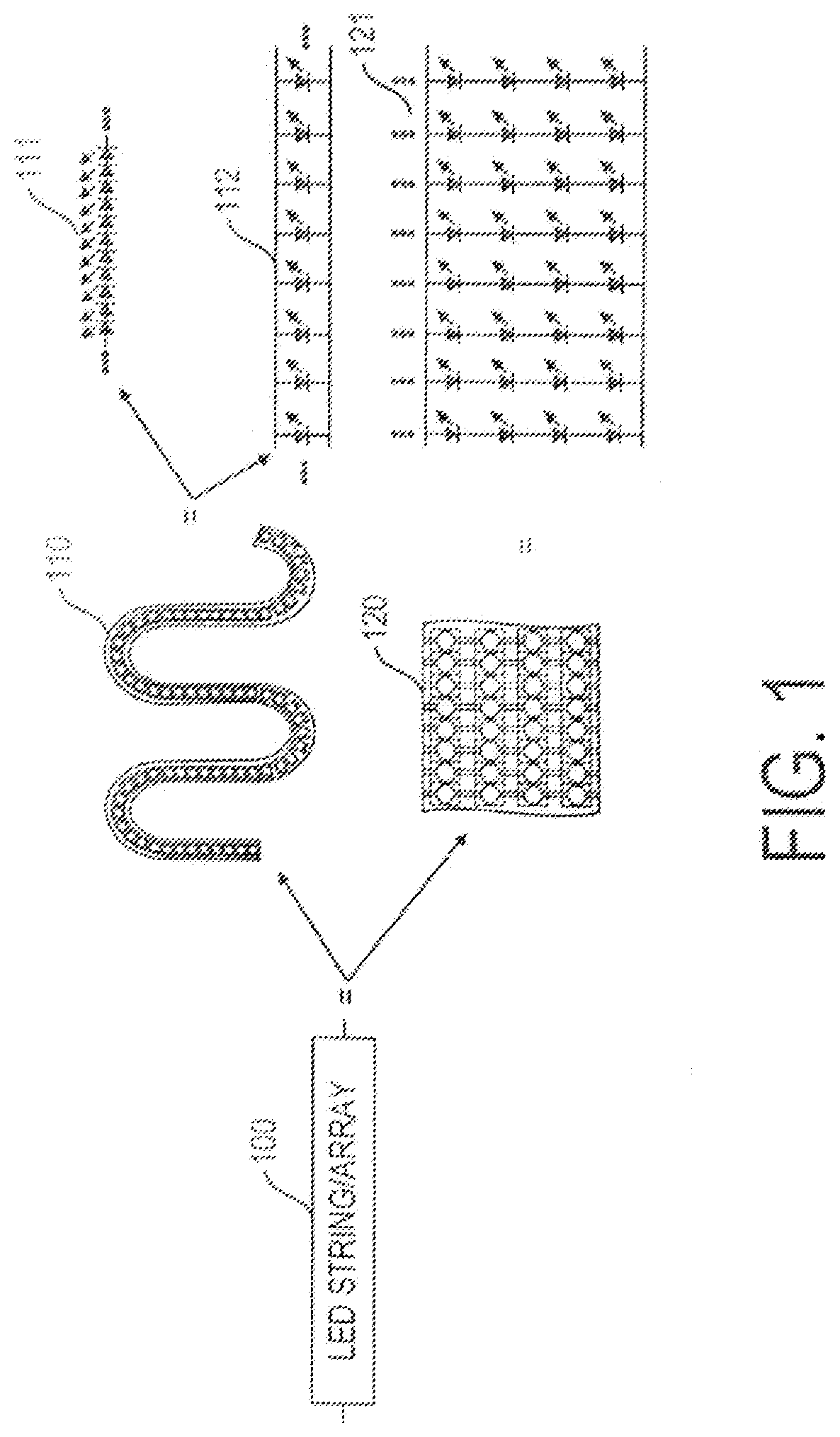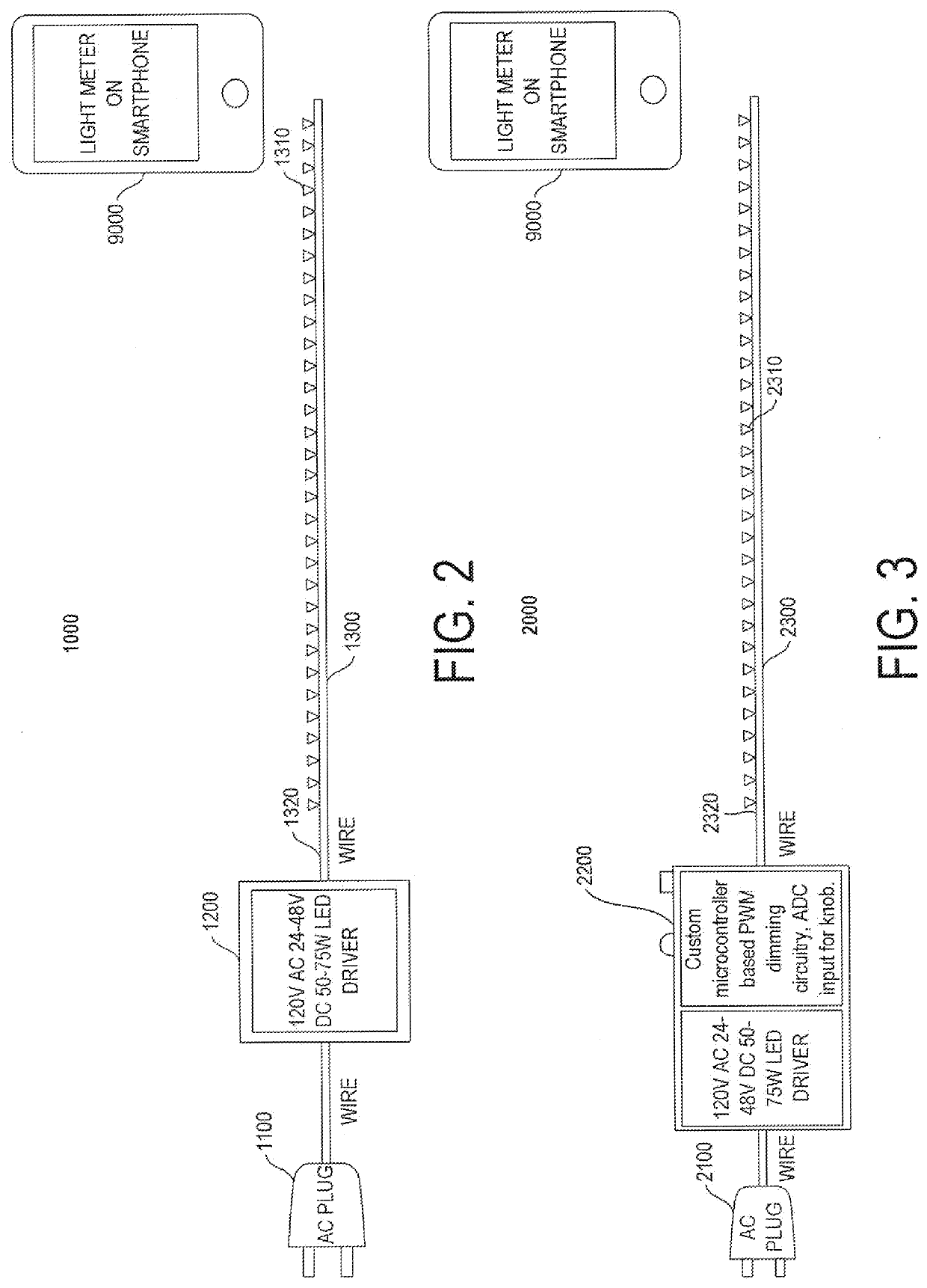Seasonal affective disorder therapeutic light system
a technology for affective disorder and therapeutic light, applied in the field of electric lightemitting health and personal care devices, can solve the problems of low energy, decreased interest in activities once enjoyed, and difficulty in concentration and mental focus, and achieve the effect of reducing barriers to patient compliance, avoiding and being able to be used on a regular basis without embarrassment or social stigma
- Summary
- Abstract
- Description
- Claims
- Application Information
AI Technical Summary
Benefits of technology
Problems solved by technology
Method used
Image
Examples
embodiment 1
[0052]FIG. 2 depicts a first embodiment of the SAD lights 100 of the present invention. Depending on the brightness or lumen-generating capacity of the LED, an LED string may consist of between thirty (30) to eighty-three (83) diodes (LEDs), depending on the target lux as described in Tables 1, 2, and 3. The LED string may be draped on or around a Christmas tree (see FIG. 6A) or other similar bush or plant in a typical decorative holiday manner, or similarly festively lining the wall / ceiling, furnishings, mirrors, or other features of home décor indoors or out. The total length of each LED or Light string ranges between approximately 5 feet to 30 feet with a preferred length of 15 feet. Other lengths of LED strings are contemplated, with corresponding increases of diodes required. The first embodiment 1000 (FIG. 2) includes an AC plug 1100, and a commercially available LED driver 1200 capable of driving a LED strip 1300 having the capability of handling the power disclosed in tables...
embodiment 2
[0054]FIG. 3 depicts an electrical diagram of a second embodiment 2000 of the present invention. The second embodiment 2000 may include additional control features of the SAD lights of the first embodiment 1000 of the present invention. The AC plug 2100, LED strip 2300, LEDS 2310 and AC wire 2320 are similar or the same as those found in the first embodiment. It may also include colored lights, or LEDs capable of changing frequency and color, for aesthetic and festive / decorative purposes, as well as other possible therapeutic (e.g., red light therapy purposes). As in FIG. 1, the embodiment in FIG. 2 may consist of a string of high-power LEDs 2300. The total length of each LED string or light string ranges between approximately 5 feet to 30 feet with a preferred length of 15 feet. Light strings may be made available in greater lengths with greater number of LEDs in total, effectively extending the total length and / or increasing the potential maximum total light intensity (lux) delive...
embodiment 3
[0055]FIG. 4 depicts a third embodiment 3000 of the present invention. This embodiment may have the LEDs configured in an array formation instead of a linear string of LEDs. This array is a fixed or net-like configuration of the conducting strings of LEDs in relation to one another, resulting in a net-like pattern or array within a pre-determined shape of fixed dimensions, with a set density of LEDs within that shape. The shape of such an array may be conical or pyramidal, or the net-like array may be square or squared, or rectangular. The array is a grid or otherwise repeated physical matrix of equally spaced LEDs, either on wires running horizontally, vertically (not shown), or both (not shown), and can be controlled via a dimmer, increasing or decreasing the brightness. In terms of the number of diodes and their spacing from one another, one may think of the array as a perfectly organized version of the string embodiment, with some segments of that string running horizontally, ot...
PUM
 Login to View More
Login to View More Abstract
Description
Claims
Application Information
 Login to View More
Login to View More - R&D
- Intellectual Property
- Life Sciences
- Materials
- Tech Scout
- Unparalleled Data Quality
- Higher Quality Content
- 60% Fewer Hallucinations
Browse by: Latest US Patents, China's latest patents, Technical Efficacy Thesaurus, Application Domain, Technology Topic, Popular Technical Reports.
© 2025 PatSnap. All rights reserved.Legal|Privacy policy|Modern Slavery Act Transparency Statement|Sitemap|About US| Contact US: help@patsnap.com



